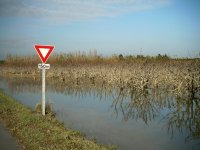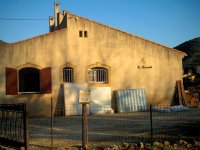|
Situated between the Alpilles to the east and the Massive
Central to the west, the Bouches-de-Rhône region is
like a bowl. When the rains come, the mountains just
funnel it all right into the Rhône. Consequently,
the result of all that rain Iíve been mentioning is widespread
flooding. I heard that the Rhône swelled to its 100-year
high-water mark, while the Durance, usually no more than
a stream, reached a 40-year mark. Thousands of people were
without water and electricity. Schools were turned into
dormitories to accommodate those forced from their homes.
Railways and roads all over the region were underwater,
and much of the Bouches-de-Rhône department was declared
a disaster area. When I arrived in October, French television
newscasts were covering the fires in California, but I wondered
how much of this flooding made the news in the US. Iíve
always found this to be an unfortunate cultural discrepancy
when traveling. People always knew much more about what
was going on in my country than I did in theirs.
It was interesting to watch the news
and see places I had just visited a week before now underwater.
As the weekend approached, I resolved to select a hike that
would allow me to see some of the devastation brought on
by the flooding. I chose a 15 km circuit originating from
Boulbon, a village near the Rhône north of Tarascon.
The first effect of the flood I encountered was the fact
that I had a very difficult time getting to Boulbon. Almost
all of the roads were closed because they were still impassable
even though the rain let up three days before. I finally
wound my way into Boulbon where the townspeople were busy
cleaning up after líinondation. The military had
been called into the region to help. Pompiers (firemen)
were going from home to home with equipment to drain ground
floors and cellars. Families were trying to salvage household
goods Ė furniture, clothes, boxes Ė by unloading them onto
their lawn in the hope that they would dry in the sun. Debris
left by the receding river was strewn all over the roads
and orchards, and where there was once water there was now
thick sticky silt.
|

Luckily the
vineyards had already been harvested.

The guest house
La Provençale tries to salvage its matresses. Guests
next summer will be trying to figure out where that funny
smell is coming from.

Another house
that didn't fare so well.
|

